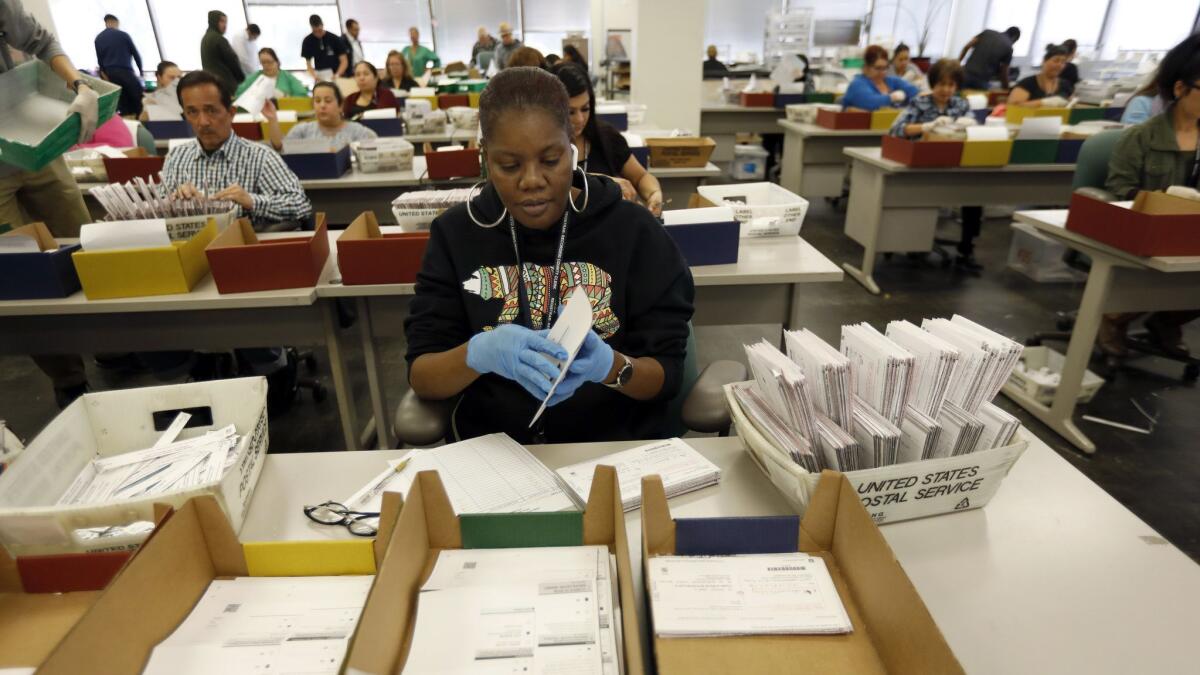Op-Ed: Direct democracy in California has been a dangerously mixed bag. It doesn’t have to be

California has just seated a new governor and legislature. But our state is not so much governed by these elected officials as by direct democracy. California’s most consequential decisions in recent years — on taxes, budget, the environment and other issues — have been made by citizens at the ballot box through the initiative process.
Legislative measures initiated in the state’s Assembly or Senate go through committees and are debated and reviewed and amended. This process, known as a “second reading,” can strengthen bills and eliminate problems with them.
By contrast, the review process for citizen ballot measures is woefully inadequate and sometimes leads to the passage of initiatives that don’t stand up to legal scrutiny. That’s what happened with Proposition 8, which outlawed same-sex marriage, and Proposition 187, which limited public services to immigrants who are here illegally. Both measures won at the polls but were later thrown out by the courts.
Citizen legislation has also produced a dysfunctional tangle of fiscal policies. Take the seminal case of Proposition 13, passed in 1978. Because property taxes were locked down, while spending for schools and public services continued to rise, deficits were inevitable.
Ballot measures have proved easy to hijack by special interests over the years.
And there was Proposition 55, passed in 2016, which has left California with a tax system so dependent on a tiny base of wealthy taxpayers that the budget is exceedingly vulnerable to economic cycles. A mere 1% of the state’s residents now pays nearly 50% of all income and capital gains taxes, the primary source of general fund revenue. That has meant that an economic downturn can lead to as much as a 25% drop in the budget.
Ballot measures have proved easy to hijack by special interests over the years, and we’ve seen real estate, tobacco and oil interests, as well as some unions, introduce measures aimed at protecting their spoils in the guise of the public good.
One example of this was Proposition 23 in 2010. A ballot measure misleadingly titled “The California Jobs Initiative” was sponsored by mostly out-of-state oil interests aimed at undoing legislation stemming greenhouse gas emissions. In the end, fortunately, the public voted against the measure. But $75 million, a record at the time, was spent by the battling sides in the campaign to sway voters to one side or the other.
Still, ballot measures are powerful tools when they work. On the up side, Californians have passed initiatives that ended gerrymandering by shifting redistricting to citizen commissions and busted partisan gridlock by requiring only a simple majority vote on budgets. Initiatives have also enacted far-reaching environmental laws to protect the coast and address climate change.
There has been some progress in fixing problems with the initiative process, but not enough. Legislation passed in 2014 amended the state’s initiative law for the first time in 40 years, requiring the secretary of state to notify the Legislature when 25% of qualifying signatures are gathered for a ballot measure. At that point legislators can seek to work with sponsors to get rid of flaws and unintended consequences or even decide to pursue the matter through legislation rather than an initiative if the sponsors agree. The Legislature is also required to hold hearings on the subject of the measure no later than 131 days before the date of the coming election.
Under the law, sponsors can withdraw their measure from the ballot by the 131-day deadline if they are able to reach a negotiated consensus on legislation. This process has already led to passage in the Legislature of a landmark minimum wage law and digital privacy legislation, both of which began as ballot propositions but were instead enacted by lawmakers.
The law could be improved, however, by requiring legislators to complete their review earlier. As it is now, the deadlines for hearings and for withdrawing a bill from the ballot are the same. If the hearings happened earlier in the process, there would be more time for legislators to negotiate compromises with ballot sponsors.
Enter the Fray: First takes on the news of the minute from L.A. Times Opinion »
Another good next step for California would be to adopt the kind of citizen review panels already up and running in Oregon. The state impanels a randomly selected group of voters to hear from a ballot measure’s proponents and opponents as well as experts on the implications of the proposed policy. The panel then presents its findings to the public through a 750-word summary published in the voter guide. When voters go to the polls, they have the advantage of being informed by the disinterested considerations of a body of their fellow citizens.
For now, the Oregon process is funded by private foundations, a model California might follow as a first step. Ultimately, however, these panels should be institutionalized in the secretary of state’s office as part of the regular electoral landscape.
As representative government is challenged around the world by disaffected citizens, more and more major decisions in democratic countries are being made directly by voters through initiatives (or referendums such as Brexit). This trend makes it all the more important to introduce additional debate and other deliberative ballast to assist citizens in making the rules that affect their lives.
Nathan Gardels is executive advisor to the Think Long Committee for California. He is coauthor with Nicolas Berggruen of the forthcoming “Renovating Democracy:Governance in the Age of Globalization and Digital Capitalism.”
More to Read
A cure for the common opinion
Get thought-provoking perspectives with our weekly newsletter.
You may occasionally receive promotional content from the Los Angeles Times.






